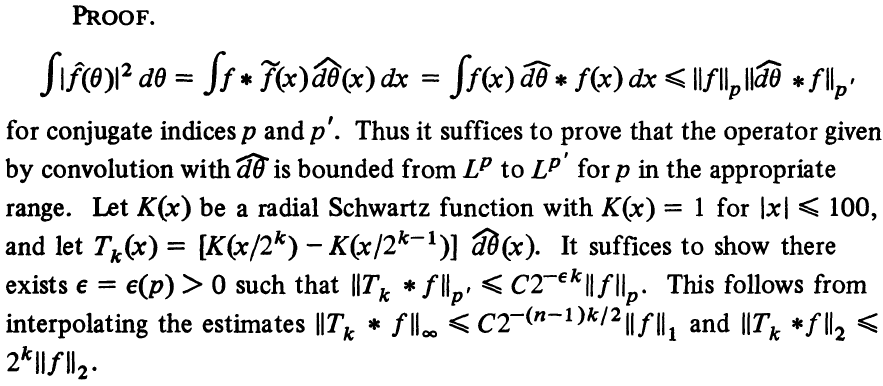I am trying to understand the proof of Tomas's theorem:
The proof reads
My question:
How do we get the estimates
$$\|T_k\ast f \|_{\infty}\lesssim 2^{-(n-1)k/2}\|f\|_{1},\qquad\qquad (1)$$ $$\|T_k\ast f \|_{2}\lesssim 2^{k}\|f\|_{2}.\qquad\qquad (2)$$
We can prove (1) by showing that
$$\|T_k \|_{\infty}\lesssim 2^{-(n-1)k/2}.\qquad \qquad (3)$$
And we can get (2) by proving that
$$\|T_k \|_{1}\lesssim 2^{k}\qquad\qquad (4).$$
I am stuck with (3) and (4).
By definition of $\widehat{d\theta}$ and $K$, we have that, for large enough $k$,
$$T_k (x)=\int_{2^{k-1}\leq |x|\leq 2^k} \left(K\left(\frac{|x|}{2^k}\right)-K\left(\frac{|x|}{2^{k-1}}\right) \right)\int_{\mathbb{S^{n-1}}}e^{\dot{\imath}x\cdot \theta}d\theta.$$
I am not sure of the latter claim of mine. We have $$k(\frac{x}{2^k})=g(\frac{|x|}{2^k})$$ where $g\in \mathcal{S}(\mathbb{R})$. So, given, $\epsilon>0$, we can find $k_{\epsilon}>1$ such that $\int_{2^{k_{\epsilon}}}^{\infty} |g(r)|dr<\epsilon$. We also have When $|x|\leq 1$ (say 1 instead of 100 in the proof) we have $K(x)=1$. So, for every $k\geq 1$, we have $$D(x):=k(\frac{x}{2^k})-k(\frac{x}{2^{k-1}})=0$$ when $|x|\leq 2^{k-1}$. That is $D$ is suppoerted in $|x|>2^{k-1}$. But, for large enough $k$, we can overlook $\int_{|x|>2^{k}}D$ because $D$ is a Schwartz function.
A second question:
The proof implicitly uses the fact that
$$\sum_{k\geq 1} \|T_k\ast f\|_{p^{\prime}}\lesssim \|f\|_{p^{\prime}}$$.
I would appreciate a hint for this too.


